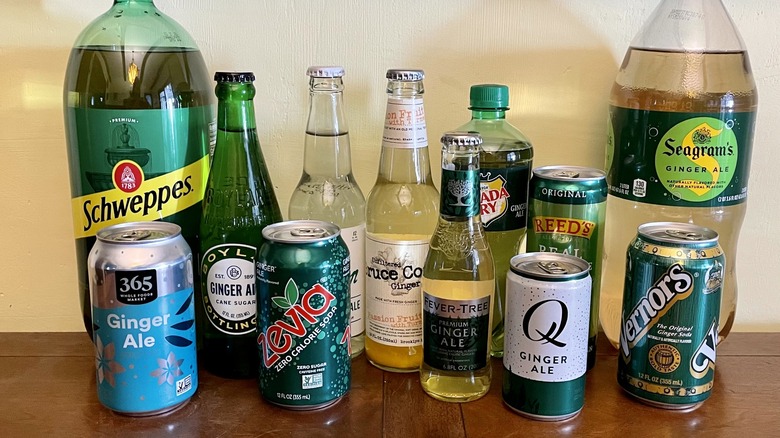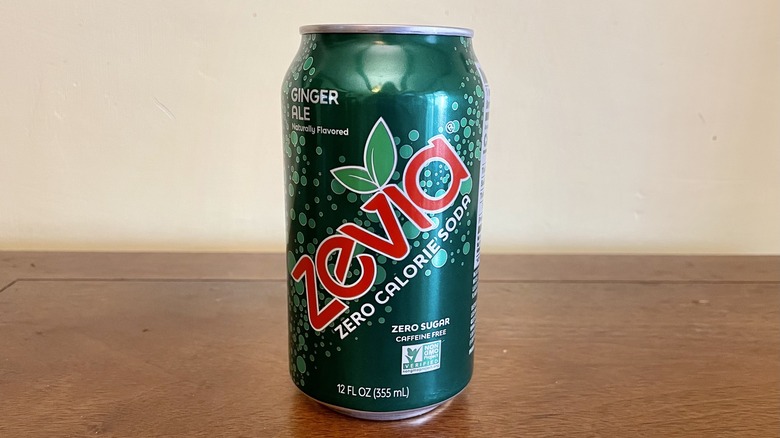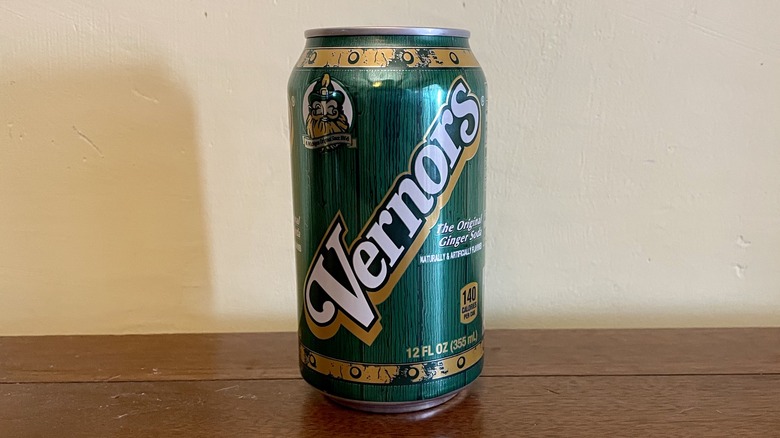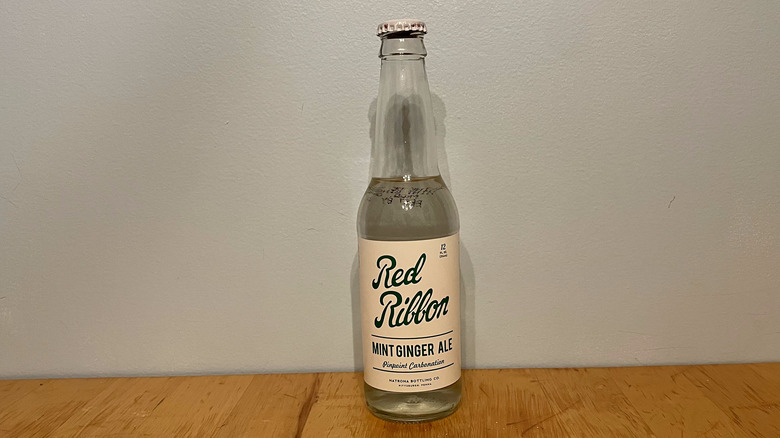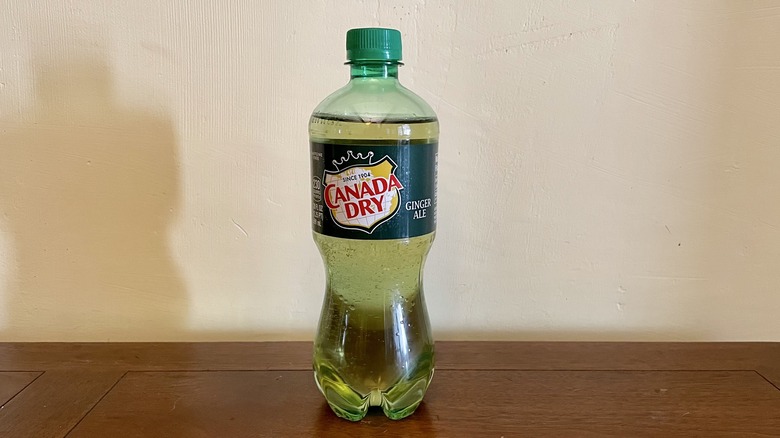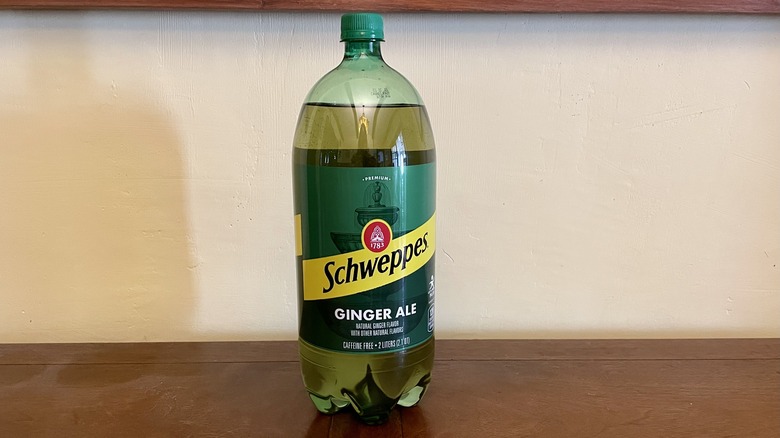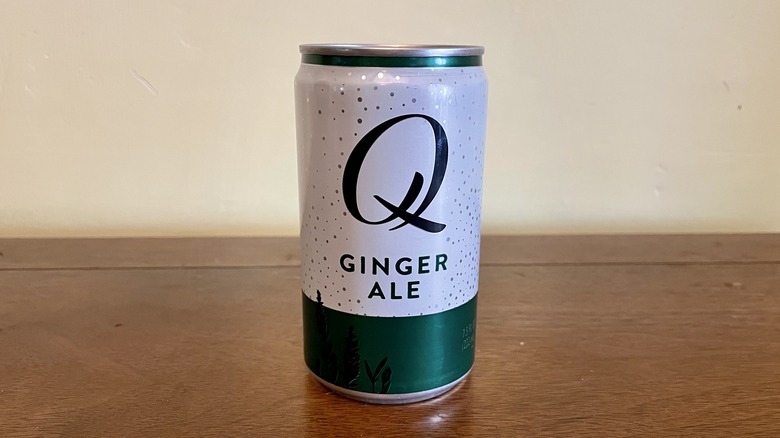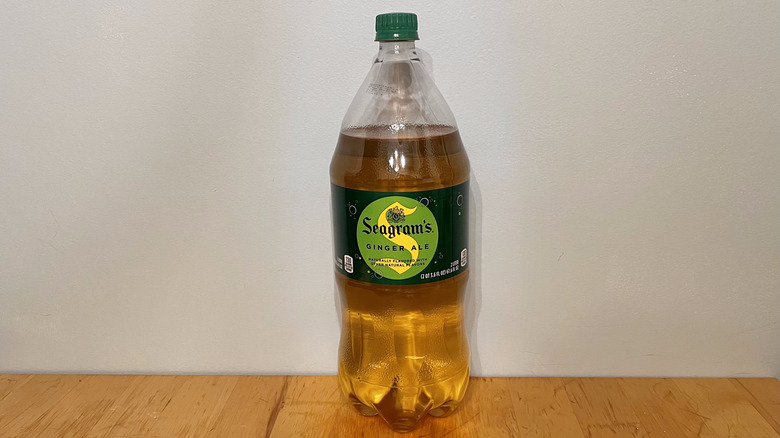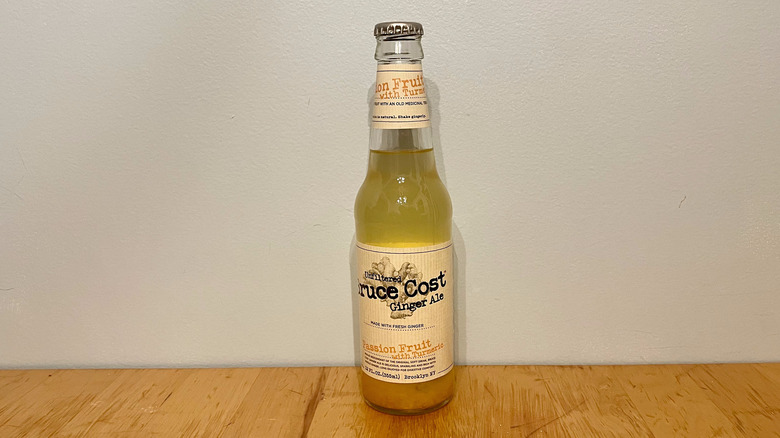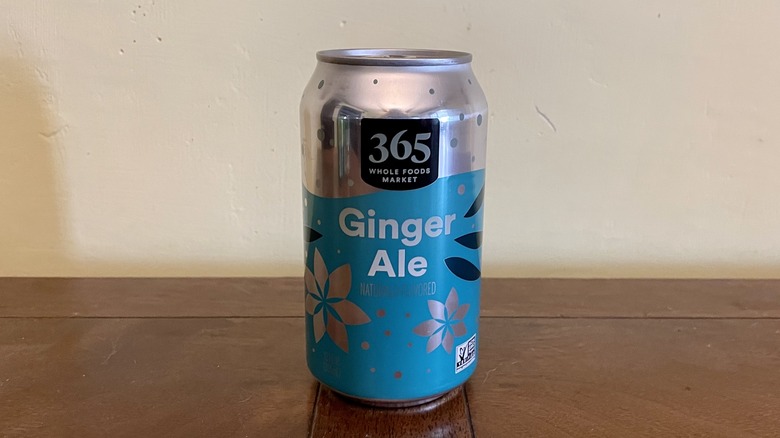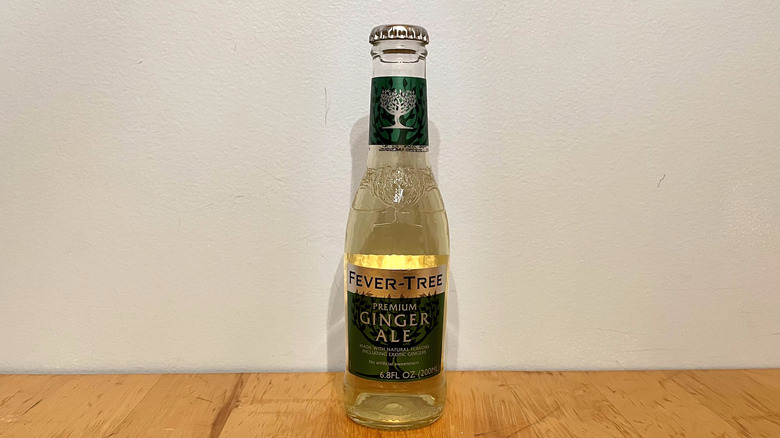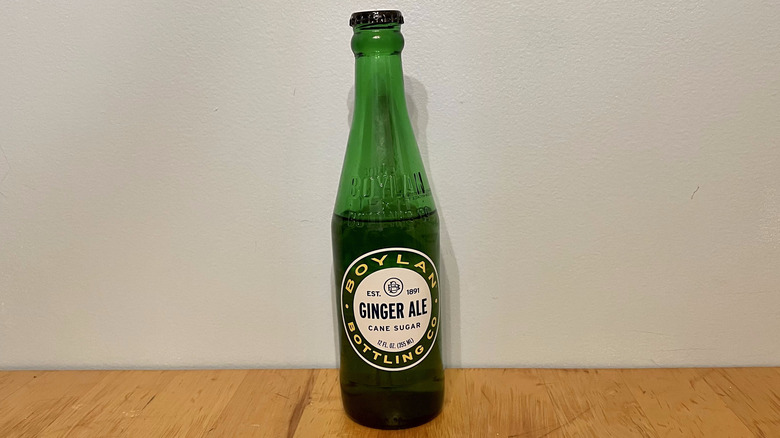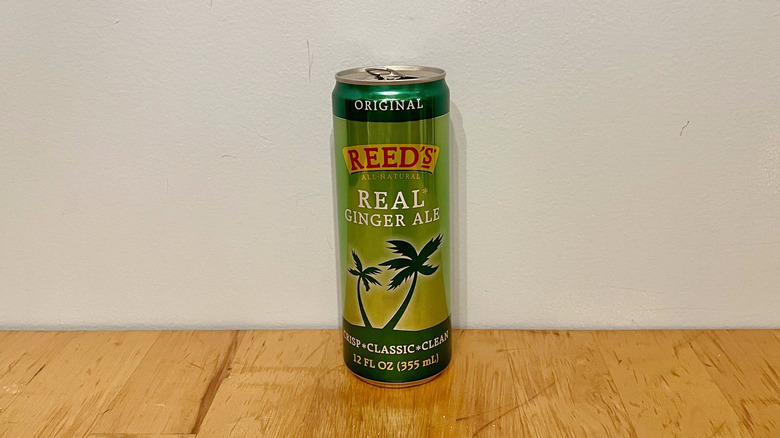12 Ginger Ale Brands Ranked Worst To Best
We may receive a commission on purchases made from links.
Ginger ale is not just for sipping when you are sick. It is one of life's great soft drinks! It is sweet, a little spicy, and herbal without being overpowering. It's great whether you drink it on its own, or use it as a cocktail mixer. There are so many types of ginger ale these days, from long-standing brands like Schweppes and Vernors to more recent trendy ones like Fever-Tree and Bruce Cost; it can be hard to tell which is the best for you, especially when people have such strong opinions on the subject.
That is why we decided to put them to the test. We pitted 12 popular ginger ale brands against each other in a taste-off and ranked them accordingly. We were looking at the quality of the bubbles, the overall sweetness level, and, of course, the final ginger flavor. We specifically tested ales, not ginger beer. While the two are similar, ginger beer tends to be brewed over a period of time, which can impart a more robust and spicier flavor. We focused on the generally milder and classic fountain drink, ginger ale. Our testing led to some surprising finds you will not want to miss.
12. Zevia
On the plus side, Zevia gave us a break from the deluge of corn syrup that has invaded every big-name brand soda on the market, and we appreciate that. The color is also completely clear, because the company's mission is to keep it as simple and clean as possible with zero sugar. In addition, they are certified gluten-free, vegan, kosher, and non-GMO.
We can respect all that. The problem is that it is functionally not drinkable. There may not be any sugar in it, but the stevia is so intense it actually overpowers the ginger flavor. This is too bad because the little ginger flavor that was there was fine. However, the stevia gave this drink an initial punch of overwhelming sweetness, followed by what tasted almost like rubbing alcohol. Maybe putting a zero sugar ginger ale on this list was not fair, but other brands on this list also have zero sugar versions, none of which are this unpleasant to drink.
11. Vernors
There was a lot of hype going into this one. As the package proclaims, they are "the original ginger soda." Various urban legends exist about the creation of the soda, but either way, in 1866, James Vernor opened a soda fountain and began serving his concoctions. Originally it was said the product was barrel aged to achieve the desired flavor; however, that no longer appears to be the case, though the design of the label mimics that of a barrel.
The first thing we noticed about Vernors was that it had a strong smell. This contrasted with Schweppes and Canada Dry, neither of which were particularly pungent. Additionally, it did have a pale golden color similar to other ginger ale. The second thing we noticed was how ungodly sweet this drink was. There is probably ginger in it. The label says there is, anyway, but you would be lucky to fight your way past the sweetness to get to it. It has more sugar than any other drink on this list. Further, the bubbles are mild and not particularly bubbly. Overall if we wanted sweet water, we would just drink sugar water. It is sad, particularly because we remember it previously being sinus clearing with all the ginger. Now it is a sad shell of its former glory.
10. Red Ribbon
It was a sad day when regional ginger ale favorite Tom Tucker Southern Style Mint Ginger Ale was taken off the shelves. Luckily, the recipe now seems to be in the hands of small bottler Natrona Bottling Company, which is producing the mint ginger ale under their Red Ribbon label. Natrona is known for its use of real cane sugar and its use of pinpoint carbonation, an old school way of adding carbonation to beverages using dry ice.
Simply put, this drink is delicious. The pinpoint carbonation creates luscious bubbles that dance on the tongue. The crystal-clear complexion perfectly matches the cool taste of the drink. It has no artificial flavors or colors. Unfortunately, it also does not have much of a ginger taste. Even the ingredient list does not shed much light on where the ginger is supposed to be. Mint is the predominant flavor in this drink, and while we would happily drink it again, we would not reach for it as a ginger ale or as a ginger ale mixer.
9. Canada Dry
Canada Dry quite frankly underwhelmed us. Maybe it was the corn syrup that left a sour and sticky residue in the mouth, or maybe it was the mildness of the ginger, but Canada Dry really did not bring the flavor for us. That being said, we understand that was kind of the point of Canada Dry.
The drink was invented by John J McLaughlin in 1904. McLaughlin wanted to create a lightly flavored and sweet ginger to appeal to the market of the time, marketing it as a pale dry Ginger Ale. The color does reflect that sentiment, offering a very light gold color. The bubbles, too, were much finer than other ginger ales.
For us, though, it may have understood the assignment a bit too well. It is so mellow it would easily get lost as a mixer, and, on its own, we can not see it doing much in the way of soothing a stomach or adding any ginger flavor. Really, all we get is sweetness and some light ginger aftertaste. If that is what you are going for, then it is a good choice, but we feel there are better ginger ales out there.
8. Schweppes
Schweppes as a company is one of the oldest, if not the oldest, soda brands still on the market today. Founded in 1783, the company first started as a mineral water company before growing and expanding. Their ginger ale did not come along until 1870, though that still makes it older than its other mass-market competitor, Canada Dry.
Speaking of which, tasting these two side by side, it is impossible not to notice the intense similarities between the two. Both offer a mild ginger flavor with a pale gold color, and both have that corn syrup aftertaste. Schweppes wins, ultimately, as the bubbles are more present and the ginger flavor is slightly more prominent, likely owing to both natural and artificial flavors. However, we want to reiterate that this win is by a hair. We are not surprised to find that both brands are owned by Keurig Dr Pepper. It does make us wonder where all this ginger ale beef between the two comes from.
7. Q
Q ginger ale is so cute in its tiny little can. The can in question is only 7.5 ounces compared to the standard 12. This makes sense, considering Q is predominantly pitched as a mixer. This may also be why the company chose to punch up the flavor, including not just ginger but also coriander, cardamom, chili peppers, orange, and rose oil. And we have to say, it kinda worked. The flavors meld together nicely, and it probably mixes well with whatever your alcohol of choice is.
Additionally, it is lower in sugar than other options, due to its use of agave instead of cane sugar, corn syrup, or stevia. This meant there was an almost honey-like flavor to it, which really brought out the rose and herb flavors. It is not necessarily ideal for drinking on its own, however, unless that is explicitly what you want, which is why we can not rank it higher. Q ginger ale is just for a single purpose. That said, we appreciate the lack of artificial colors or flavors and the unique blend it offers.
6. Seagram's
Of the big three store brands, Schweppes, Canada Dry, and Seagram's, Seagram's is the clear winner. Still, it is by no means a perfect ginger ale. Seagram's still suffers from being a high fructose corn syrup-based drink, which brings with it the sticky aftertaste that just will not quit. However, it does it in a pleasant and refreshing way.
The bubbles on this bottle were fine and plentiful, rolling over the tongue pleasantly. We felt it offered the most ginger flavor of the three and would likely hold up as a mixer even against strong-flavored alcohols, such as whisky and rum. We are unsurprised it is marketed as a good mixer.
Unlike Schweppes, Canada Dry, and Vernors, Seagram's is not owned by Keurig Dr Pepper. Instead, it is owned by Coca-Cola. Also, unlike some other ginger ales on this list, there are no artificial flavors in it. One thing we do wonder, though, is why they continue to use artificial colors in it. Like many of the other mass-market brands, caramel coloring is added, which does nothing to affect the taste. Other brands achieve the color through other means or are simply bottled clear.
5. Bruce Cost
We are not going to lie. We had some high expectations for this one, considering it is the single most expensive bottle on this list by a noticeable margin. A simple four-pack costs $10.79. For the uninitiated, Bruce Cost makes unfiltered ginger ale out of fresh ginger. One look at the bottom of the bottle shows sediment from the flavors that have been added. We were pretty impressed with this, though it did mean we had to carefully turn the bottle over to mix everything before opening it.
Bruce Cost makes a whole line of ginger ales in different flavors. In our area, the passion fruit with turmeric is what was available, so we opted to try it, bearing in mind there is a straight-up original.
The aroma of the Bruce Cost is easily the most ginger filled. The whole drink smells like fresh-cut ginger. One sip and you also get hit with fresh, spicy, tangy ginger, which is well balanced with the cane sugar of the drink. In this particular flavor, the passion fruit and turmeric blend beautifully with the ginger flavor and provide a lovely yellow color. Our main complaint remains that it is really expensive. This is a great choice as a treat, especially if you like flavored ginger drinks, but we would never use a drink like this as a mixer. There are other ginger ales out there that are more prominently ginger.
4. 365
365 are Whole Foods brand products. When it comes to generic store-brand versions of soda, the bar is not set particularly high. No one expects much from them, and so we were pleasantly surprised with the 365 ginger ale. Not only that, we would actively choose it over most other store brands every time.
When we first opened the can, we noticed there was not much in the way of smell; this was similar to Canada Dry. We poured it out and noticed there was the very faintest hint of color in it. After checking the ingredients, we saw there was some color added, but we honestly wondered why they bothered because it was so pale. One sip, though, and we were sold.
If you prefer a mild, pale ginger ale, this is a solid choice. It offers a mild flavor similar to Canada dry and Shwepps with one big improvement: cane sugar. Until you try it, you do not understand the game changer this will be. It has roughly the same amount of sugar as the other brands, but there is no weird film in your mouth, no sour aftertaste — just ginger and sweetness.
3. Fever-Tree
Fever-Tree markets itself as a premium ginger ale. While this means that, yes, they charge more for the drink, we did also notice a noticeable higher quality in the product. A four-pack of the relatively small bottles was $5.99. The drink was made with cane sugar, not corn syrup, had only natural flavors, and was in a fancy glass bottle. Maybe it was the glass bottle that did it, but Fever-Tree had one of the most straightforward flavors of any of the ginger ales we tried.
With a light color and fine bubble, it has a slight bite without being too intense. It played on the tongue well and could easily stand up with any mixers. The major downsides were size and price. As a drink marketed as a mixer, the bottles are small; this one is just 6.8 oz, even smaller than the Q container. It is also on the pricey side, and while good, there are better, more ginger-forward ginger ales out there.
2. Boylan
Boylan has very nearly hit the mark with this one. It comes in a classic green glass bottle that harkens to a vintage vibe that perfectly matches their founding in 1891. The recipe also feels like it could be an original recipe. The company strove to make a pale ginger ale, and absolutely did. While some ginger drinks may be too intensely gingery, Boylan created a drink that epitomizes the pale ginger ale category.
The ingredients include real ginger and actual cane sugar. This gives it a clean, sweet flavor without any odd aftertaste from corn-based sweeteners.
The drink was so nearly perfect, but we just had a few complaints. The first is that, in addition to ginger, the company adds lemon and lime oils. It is delicious, but it does make the drink more of a mixed flavor palate, though not as much as Q ginger ale. The second is there is still some added caramel color, which we find unnecessary for the overall appeal of the drink.
1. Reed's Real ginger ale
The bottle says crisp, classic, and clean, and it absolutely lives up to it. Reed's Reel ginger ale is everything we could want from ginger ale. As soon as you open the can, you are hit with the spicy smell of ginger. It is made with no coloring, so we know the pale yellow is natural. Additionally, it has an almost cloudy look to it. This is actually to its advantage as it shows there is actually a noticeable amount of pressed ginger in the drink.
The bubbles are rich and pleasant and do not dissipate quickly. Even left open for a time, when we returned, there was still a pleasant amount of bubbles left in the cup.
We are unsurprised that Reed's does ginger drinks well; it is what they do. They also have ginger beer, ginger candy, and a low-calorie version of their ginger ale. They know ginger and know how to turn it into a simple but effective drink that is neither too spicy nor too sweet.
